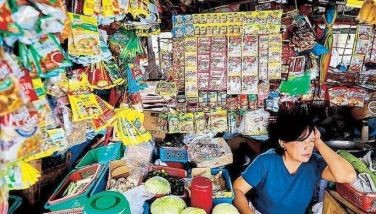Gen Zs defining next era of retail

Special Report
MANILA, Philippines — Are skinny jeans back in style? If you are a millennial, you might say they never left and you might even be wearing them now.
Skinny jeans reigned supreme until Gen Z decided to end that era to make way for a loose fit, leading to stores carrying more of the other styles like straight leg jeans, wide leg jeans, baggy jeans, cargo pants and flared pants.
Gen Zs may be young but their ability to influence what’s in or out is very strong. Because they’re woke, they’re environmentally conscious and they have climate anxiety so they don’t like fast fashion.
Thus, they love to go thrifting for pre-loved items. The boomers and Gen Xs call it ukay-ukay. The Gen Zs call it thrifting. It’s no surprise pop-up thrift stores have sprouted in Gen Z hangouts within campus districts.
Not surprisingly, retailers are paying more attention to this age group to remain relevant in the market.
What is Gen Z?
According to a report from global consultancy Bain & Company, Meta and DSG Consumer Partners, Gen Z consumers or those born between 1997 and 2012, are among the segments expected to drive consumption growth in Southeast Asia.
This demographic cohort accounts for 23 percent of Southeast Asia’s total population.
With its growing size and spending power, Gen Z is seen as an influential segment for businesses.
As digital natives, Gen Z consumers are spending a lot of time online.
McKinsey & Company partner Simon Wintels said in an email that a survey conducted in the Asia-Pacific covering Gen Zers, millennials and Gen Xers showed how Gen Z consumers differ from other cohorts when it comes to making purchases.
“They (Gen Zs) rely on social media, but are thoughtful about how they engage with it,” he said.
In most countries surveyed, he said, Gen Zs spend more time on their phones and social media, which may explain why 50 to 60 percent of the primary influence in brand decisions for these individuals comes from social media and online sites.
Wintels said Gen Zs’ brand selection is also greatly influenced by video content, with Gen Zs viewing significantly more video media on platforms such as YouTube or TikTok than other cohorts do.
Through video-based social media, he said Gen Zs are able to learn about new brands.
Huiyan Pan, regional marketing lead at Shopee said in an interview that a study conducted with Kantar revealed that seven in 10 Filipino Gen Z consumers, who are 18 to 24 years old, are shopping online, with e-commerce being the main point of contact.
She said having a good quality product or service is also very important for these young individuals, with quality being a top factor for their shopping consideration.
Aside from spending time online or on social media, McKinsey’s Wintels said Gen Zs “want it all – and are used to getting it.”
He said these young individuals prefer to do their own research before they shop and are especially interested in finding deals.
They are also more likely to regularly look for discounts than millennials or those part of Gen X, as these young individuals generally have less money to spend than their counterparts in the older generation.
While Gen Zs are looking for deals when making purchases, Wintels said they are not willing to sacrifice quality for price.
They also prefer brands or items that show their personality and uniqueness.
“Gen Zs’ preference for uniqueness stems from the challenging times they’re growing up in, both geopolitically and environmentally. With so much conflicting information around them, trust can be difficult to establish. As a result, they reject conformity and resist being labeled. They find security in expressing their true selves,” Wintels said.
Despite Gen Z wanting to be seen as environmentally conscious and caring about sustainable consumption, he said these consumers often don’t want to pay more for environmentally responsible products.
Thrifting for sustainability
This preference for uniqueness and individuality, as well as sustainable brands has given rise to the popularity of thrifting.
Tiffany Guibani, 22, said she usually shops through online thrift stores where the sellers often do live selling or post thrifted items.
“In general, I love thrift shopping because of the number of items you could purchase with a certain amount of money. People think that thrifted items are those of less quality, but in reality, some stores sell overruns from known brands or others may even be authentic or vintage luxury brands. It all depends on how meticulous and determined you are to find good items,” she said.
Michaela Maceda, a student from Antipolo, likes to go thrifting because of the variety of pieces to choose from.
“It’s like a treasure hunt. If you are patient, you will find really rare pieces. It is also cheaper to buy than in fast fashion stores even when they’re on sale. And of course, it’s more sustainable,” Maceda said.
While they shop online, Gen Z shoppers are also still attracted to brick and mortar stores.
“Shopping at a physical store is still convenient and favorable at times. You get to see the items in person, get a feel of their quality and instantly take it home with you,” Guibani said.
Opportunities for retailers
The Philippines’ higher average gross domestic product (GDP) growth rate of 6.4 percent from 2021 to 2023 than the 6.2 percent from 2017 to 2019, as well as the continued expectation of average six percent GDP growth over the next seven years provide a highly attractive macroeconomic playground for retailers.
This is according to Yukiko Tsukamoto, partner at Bain & Company.
In an email, she said the median disposable income per household in the country, which rose by 10 percent over the last year, is among the highest growth rates in Asia-Pacific.
In addition, she said expectations that the Philippines may witness a population growth of 2.5 percent over the next seven years provides retailers with the promise of a budding customer base with increasing affluence.
“A high-growth economic environment coupled with low competition provides a remarkable, albeit potentially short window to retailers to scale their core business. As a result, retailers will need to evade the trap of growth at all costs and prioritize sustained profitable growth,” she said.
She said this can be done by enhancing core retail capabilities to unlock full potential productivity through assortment optimization, private label, buying, pricing and promotions, exploring mergers and acquisitions and sharpening differentiation.
As companies consider how to approach Gen Z, Wintels said they have to keep in mind that these young consumers are more likely to try out new brands and products compared to Millennials. They also drop brands that don’t deliver.
“To stay relevant in the market, brands can consider leveraging their legacy while investing in fast and continuous innovations. This can be done through partnerships and collaborations with the same speed as smaller and younger brands,” he said.
As both quality and price are prerequisites for Gen Z consumers, he said companies can look at ways to be more stringent in deciding which features to keep and which to deemphasize.
For McKinsey & Company, businesses also have to think about the critical role videos play in influencing how Gen Z consumers choose brands and products.
“Brands that speak to Generation Z through informative, fun and inspiring videos therefore stand a better chance of being shared—and thus cutting through the noise. Building social-media marketing capabilities is critical for brands, whether real time or curated, to engage with consumers,” Wintels said.
To capture a bigger share of the Gen Z wallet, he said companies will have to think about how sustainable products can strike a balance between quality and environmental values.
“Many small and successful ethical brands stand out by emphasizing their quality and story through package design and by media content on the stories behind their products. Bigger brands that want to expand their sustainable portfolios could do the same, while ensuring that they genuinely deliver what they promise,” he said.
He said brands also need to ensure their value proposition and messaging are tailored to the local context as consumers are naturally influenced by their distinct cultural attributes, lifestyles, religions and eating habits.
Digital natives
Recognizing the opportunities presented by the rise in Gen Z consumers, Pan said Shopee has been undertaking efforts to better understand this next generation of shoppers with the goal of not just improving how to connect with them, but also the overall shopping experience of all the e-commerce platform’s users.
“The reason why we want to understand them is that they are digital natives. They live and breathe and grew up with digital. So we feel that they are probably at the forefront in what is the best experience,” she said.
To enhance the shopping experience for Gen Z consumers, Shopee has tapped members of P-pop girl group BINI as the e-commerce platform’s new brand ambassadors.
“We are building our community with the newest generation and we love to collaborate with ambassadors and representatives whom they can relate to and ultimately who represent this generation. Their energy, youthful vibe align with the online shopping experience that we want our users to have on Shopee,” Pan said.
The e-commerce platform has also introduced innovations to address the pain points of Gen Z consumers including the COD (cash-on-delivery) Unbox: Return on the Spot, which allows COD customers to open and inspect items in their parcel upon delivery and to return this to the delivery rider immediately if the order is incorrect, damaged or has missing items.
Another enhancement is the Change of Mind feature, which allows customers to return products if the fit and style do not suit them.
In addition, Shopee has a new On-Time Delivery program, which involves giving users a free discount voucher if their order arrives later than the delivery date.
For his part, Philippine Retailers Association (PRA) president Roberto Claudio said local retailers are taking steps to better cater to the needs of Gen Z consumers.
“Many of our traditional retailers have moved into e-commerce, which was hastened by the pandemic,” he said.
According to data and analytics company GlobalData, the country’s e-commerce market has registered a compound annual growth rate (CAGR) of 28.6 percent between 2019 and 2023, with last year’s value reaching P1.1 trillion.
GlobalData expects the Philippine e-commerce market between this year and 2028 to rise at a CAGR of 13.2 percent, with the value projected to hit P2.2 trillion in 2028.
The e-commerce growth is expected to be supported by consumers’ preference to shop online, government initiatives, as well as the entry of new players.
Claudio said local retailers are serving customers based on their preferences through online stores and physical stores.
“If they want to be served at home, you do it at the fastest and best possible price. If they want to go to the store, give them the best experience you can give,” he said.
Given Gen Zs’ emphasis on their individuality, Claudio said retailers are addressing this through personalization of product mix and availability of more varieties, color options and model selections.
He said PRA also continues to offer seminars and education programs to local retailers to keep them informed on developments in artificial intelligence, retail technologies and in diversifying supply chain options.
Now as to whether or not skinny jeans are cool again, you will just have to check what’s in Gen Zs’ GRWM (get ready with me) videos.
- Latest
- Trending




























